Recent Advances in Lithium Extraction Using Electrode Materials of Li-Ion Battery from Brine/Seawater
Abstract
:1. Introduction
2. Electrochemical Lithium-Recovery Systems
2.1. Water-Splittig Battery System
2.2. Asymmetric-Battery System
2.3. Hybrid Supercapacitor System
2.4. Symmetric Rocking-Chair-Battery System
3. Electrode Materials
3.1. Working Materials
3.1.1. LiFePO4-Based Materials
3.1.2. LiMn2O4-Based Materials
3.1.3. Multi-Component Composite Materials
3.2. Counter Electrodes
3.2.1. Metal Materials
3.2.2. Non-Metallic Material
4. Conclusions and Prospect
4.1. Electrochemical Li-Recovery Systems
4.2. Electrode Materials
Author Contributions
Funding
Data Availability Statement
Conflicts of Interest
References
- Sun, J.; Zhou, Y.; Zhao, Z.; Meng, X.; Li, Z. Modification strategies to improve electrocatalytic activity in seawater splitting: A review. J. Mater. Sci. 2022, 57, 19243–19259. [Google Scholar] [CrossRef]
- Zhao, Z.; Sun, J.; Meng, X. Recent advances in transition metal-based electrocatalysts for seawater electrolysis. Int. J. Energy Res. 2022, 46, 17952–17975. [Google Scholar] [CrossRef]
- Liu, S.; Sun, J.; Ren, G.; Meng, X. Vacancy-engineered bismuth-based semiconductor with enhanced photocatalytic activity: A review. Mater. Sci. Semicond. Process. 2022, 137, 106230. [Google Scholar] [CrossRef]
- Li, J.; Sun, J.; Li, Z.; Meng, X. Recent advances in electrocatalysts for seawater splitting in hydrogen evolution reaction. Int. J. Hydrogen Energy 2022, 47, 29685–29697. [Google Scholar] [CrossRef]
- Sun, J.; Zhao, Z.; Li, J.; Li, Z.; Meng, X. Recent advances in transition metal selenides-based electrocatalysts: Rational design and applications in water splitting. J. Alloys Compd. 2022, 918, 165719. [Google Scholar] [CrossRef]
- Hoshino, T. Innovative lithium recovery technique from seawater by using world-first dialysis with a lithium ionic super-conductor. Desalination 2015, 359, 59–63. [Google Scholar] [CrossRef] [Green Version]
- Li, Z.; Li, C.; Liu, X.; Cao, L.; Li, P.; Wei, R.; Li, X.; Guo, D.; Huang, K.-W.; Lai, Z. Continuous electrical pumping membrane process for seawater lithium mining. Energy Environ. Sci. 2021, 14, 3152–3159. [Google Scholar] [CrossRef]
- Choubey, P.K.; Kim, M.-S.; Srivastava, R.R.; Lee, J.-C.; Lee, J.-Y. Advance review on the exploitation of the prominent energy-storage element: Lithium. Part I: From mineral and brine resources. Miner. Eng. 2016, 89, 119–137. [Google Scholar] [CrossRef]
- Choubey, P.K.; Chung, K.-S.; Kim, M.-S.; Lee, J.-C.; Srivastava, R.R. Advance review on the exploitation of the prominent en-ergy-storage element Lithium. Part II: From sea water and spent lithium-ion batteries (LIBs). Miner. Eng. 2017, 110, 104–121. [Google Scholar] [CrossRef]
- Zhang, X.; Han, A.; Yang, Y. Review on the production of high-purity lithium metal. J. Mater. Chem. 2020, 8, 22455–22466. [Google Scholar] [CrossRef]
- Yang, S.; Zhang, F.; Ding, H.; He, P.; Zhou, H. Lithium Metal Extraction from Seawater. Joule 2018, 2, 1648–1651. [Google Scholar] [CrossRef] [Green Version]
- Geological Survey. Mineral Commodity Summaries; Mineral Commodity Summaries: Reston, VA, USA, 2020; p. 204. [Google Scholar]
- Swain, B. Recovery and recycling of lithium: A review. Sep. Purif. Technol. 2017, 172, 388–403. [Google Scholar] [CrossRef]
- Gruber, P.W.; Medina, P.A.; Keoleian, G.A.; Kesler, S.E.; Everson, M.P.; Wallington, T.J. Global Lithium Availability. J. Ind. Ecol. 2011, 15, 760–775. [Google Scholar] [CrossRef]
- Baturin, G.N. Mineral resources of the ocean. Lithol. Miner. Resour. 2000, 35, 399–424. [Google Scholar] [CrossRef]
- Diallo, M.S.; Kotte, M.R.; Cho, M. Mining Critical Metals and Elements from Seawater: Opportunities and Challenges. Environ. Sci. Technol. 2015, 49, 9390–9399. [Google Scholar] [CrossRef]
- Liu, D.; Li, Z.; He, L.; Zhao, Z. Facet engineered Li3PO4 for lithium recovery from brines. Desalination 2021, 514, 115186. [Google Scholar] [CrossRef]
- Zhao, C.; He, M.; Cao, H.; Zheng, X.; Gao, W.; Sun, Y.; Zhao, H.; Liu, D.; Zhang, Y.; Sun, Z. Investigation of solution chemistry to enable efficient lithium recovery from low-concentration lithium-containing wastewater. Front. Chem. Sci. Eng. 2019, 14, 639–650. [Google Scholar] [CrossRef]
- Lai, X.; Xiong, P.; Zhong, H. Extraction of lithium from brines with high Mg/Li ratio by the crystallization-precipitation method. Hydrometallurgy 2020, 192, 105252. [Google Scholar] [CrossRef]
- Graham, T.R.; Hu, J.Z.; Zhang, X.; Dembowski, M.; Jaegers, N.R.; Wan, C.; Bowden, M.; Lipton, A.S.; Felmy, A.R.; Clark, S.B.; et al. Pearce, Unraveling Gibbsite Transformation Pathways into LiAl-LDH in Concentrated Lithium Hydroxide. Inorg. Chem. 2019, 58, 12385–12394. [Google Scholar] [CrossRef]
- Jiang, H.; Yang, Y.; Sun, S.; Yu, J. Adsorption of lithium ions on lithium-aluminum hydroxides: Equilibrium and kinetics. Can. J. Chem. Eng. 2019, 98, 544–555. [Google Scholar] [CrossRef]
- Zhong, J.; Lin, S.; Yu, J. Effects of excessive lithium deintercalation on Li+ adsorption performance and structural stability of lithium/aluminum layered double hydroxides. J. Colloid Interface Sci. 2020, 572, 107–113. [Google Scholar] [CrossRef] [PubMed]
- Wang, H.; Cui, J.; Li, M.; Guo, Y.; Deng, T.; Yu, X. Selective recovery of lithium from geothermal water by EGDE cross-linked spherical CTS/LMO. Chem. Eng. J. 2020, 389, 124410. [Google Scholar] [CrossRef]
- Shi, D.; Cui, B.; Li, L.; Peng, X.; Zhang, L.; Zhang, Y. Lithium extraction from low-grade salt lake brine with ultrahigh Mg/Li ratio using TBP—Kerosene—FeCl3 system. Sep. Purif. Technol. 2018, 211, 303–309. [Google Scholar] [CrossRef]
- Gu, D.; Sun, W.; Han, G.; Cui, Q.; Wang, H. Lithium-ion sieve synthesized via an improved solid state method and adsorption performance for West Taijinar Salt Lake brine. Chem. Eng. J. 2018, 350, 474–483. [Google Scholar] [CrossRef]
- Wang, S.; Li, P.; Zhang, X.; Zheng, S.; Zhang, Y. Selective adsorption of lithium from high Mg-containing brines using HxTiO3 ion sieve. Hydrometallurgy 2017, 174, 21–28. [Google Scholar] [CrossRef]
- Ji, P.-Y.; Ji, Z.-Y.; Chen, Q.-B.; Liu, J.; Zhao, Y.-Y.; Wang, S.-Z.; Li, F.; Yuan, J.-S. Effect of coexisting ions on recovering lithium from high Mg2+/Li+ ratio brines by selective-electrodialysis. Sep. Purif. Technol. 2018, 207, 1–11. [Google Scholar] [CrossRef]
- Guo, Z.-Y.; Ji, Z.-Y.; Chen, Q.-B.; Liu, J.; Zhao, Y.-Y.; Li, F.; Liu, Z.-Y.; Yuan, J.-S. Prefractionation of LiCl from concentrated sea-water/salt lake brines by electrodialysis with monovalent selective ion exchange membranes. J. Clean. Prod. 2018, 193, 338–350. [Google Scholar] [CrossRef]
- Liu, G.; Zhao, Z.; He, L. Highly selective lithium recovery from high Mg/Li ratio brines. Desalination 2019, 474, 114185. [Google Scholar] [CrossRef]
- Tansel, B. Significance of thermodynamic and physical characteristics on permeation of ions during membrane separation: Hydrated radius, hydration free energy and viscous effects. Sep. Purif. Technol. 2012, 86, 119–126. [Google Scholar] [CrossRef]
- Pasta, M.; Battistel, A.; La Mantia, F. Batteries for lithium recovery from brines. Energy Environ. Sci. 2012, 5, 9487–9491. [Google Scholar] [CrossRef]
- Trócoli, R.; Battistel, A.; La Mantia, F. Selectivity of a Lithium-Recovery Process Based on LiFePO4. Chem. Eur. J. 2014, 20, 9888–9891. [Google Scholar] [CrossRef] [PubMed]
- Kim, S.; Joo, H.; Moon, T.; Kim, S.-H.; Yoon, J. Rapid and selective lithium recovery from desalination brine using an electro-chemical system. Environ. Sci. Process. Impacts J. 2019, 21, 667–676. [Google Scholar] [CrossRef]
- Liu, C.; Li, Y.; Lin, D.; Hsu, P.-C.; Liu, B.; Yan, G.; Wu, T.; Cui, Y.; Chu, S. Lithium Extraction from Seawater through Pulsed Electrochemical Intercalation. Joule 2020, 4, 1459–1469. [Google Scholar] [CrossRef]
- Kanoh, H.; Ooi, K.; Miyai, Y.; Katoh, S. Electrochemical Recovery of Lithium Ions in the Aqueous Phase. Sep. Sci. Technol. 1993, 28, 643–651. [Google Scholar] [CrossRef]
- Kanoh, H.; Ooi, K.; Miyai, Y.; Katoh, S. Selective electroinsertion of lithium ions into a platinum/lambda.-manganese dioxide electrode in the aqueous phase. Langmuir 1991, 7, 1841–1842. [Google Scholar] [CrossRef]
- Lee, J.; Yu, S.-H.; Kim, C.; Sung, Y.-E.; Yoon, J. Highly selective lithium recovery from brine using a λ-MnO2–Ag battery. Phys. Chem. Chem. Phys. 2013, 15, 7690–7695. [Google Scholar] [CrossRef]
- Zhao, A.; Liu, J.; Ai, X.; Yang, H.; Cao, Y. Highly Selective and Pollution-Free Electrochemical Extraction of Lithium by a Pol-yaniline/LixMn2O4 Cell. ChemSusChem 2019, 12, 1361–1367. [Google Scholar] [CrossRef]
- Wessells, C.D.; Huggins, R.A.; Cui, Y. Copper hexacyanoferrate battery electrodes with long cycle life and high power. Nat. Commun. 2011, 2, 550. [Google Scholar] [CrossRef] [Green Version]
- Wessells, C.D.; Peddada, S.V.; Huggins, R.A.; Cui, Y. Nickel Hexacyanoferrate Nanoparticle Electrodes for Aqueous Sodium and Potassium Ion Batteries. Nano Lett. 2011, 11, 5421–5425. [Google Scholar] [CrossRef]
- Wang, Q.; Wen, Z.H.; Li, J. A Hybrid Supercapacitor Fabricated with a Carbon Nanotube Cathode and a TiO2–B Nanowire Anode. Adv. Funct. Mater. 2006, 16, 2141–2146. [Google Scholar] [CrossRef]
- Joo, H.; Lee, J.; Yoon, J. Short Review: Timeline of the Electrochemical Lithium Recovery System Using the Spinel LiMn2O4 as a Positive Electrode. Energies 2020, 13, 6235. [Google Scholar] [CrossRef]
- Kim, S.; Lee, J.; Kang, J.S.; Jo, K.; Kim, S.; Sung, Y.-E.; Yoon, J. Lithium recovery from brine using a λ-MnO2/activated carbon hybrid supercapacitor system. Chemosphere 2015, 125, 50–56. [Google Scholar] [CrossRef] [PubMed]
- Ryu, T.; Ryu, J.C.; Shin, J.; Lee, D.H.; Kim, Y.H.; Chung, K.-S. Recovery of Lithium by an Electrostatic Field-Assisted Desorption Process. Ind. Eng. Chem. Res. 2013, 52, 13738–13742. [Google Scholar] [CrossRef]
- Zhang, Y.; Xin, P.; Yao, Q. Electrochemical performance of LiFePO4/C synthesized by sol-gel method as cathode for aqueous lithium-ion batteries. J. Alloys Compd. 2018, 741, 404–408. [Google Scholar] [CrossRef]
- Alias, N.; Mohamad, A.A. Advances of aqueous rechargeable lithium-ion battery: A review. J. Power Sources 2015, 274, 237–251. [Google Scholar] [CrossRef]
- Luo, J.-Y.; Cui, W.-J.; He, P.; Xia, Y.-Y. Raising the cycling stability of aqueous lithium-ion batteries by eliminating oxygen in the electrolyte. Nat. Chem. 2010, 2, 760–765. [Google Scholar] [CrossRef]
- Zhao, Z.; Si, X.; Liu, X.; He, L.; Liang, X. Li extraction from high Mg/Li ratio brine with LiFePO4/FePO4 as electrode materials. Hydrometallurgy 2013, 133, 75–83. [Google Scholar] [CrossRef]
- Guo, Z.-Y.; Ji, Z.-Y.; Chen, H.-Y.; Liu, J.; Zhao, Y.-Y.; Li, F.; Yuan, J.-S. Effect of Impurity Ions in the Electrosorption Lithium Extraction Process: Generation and Restriction of “Selective Concentration Polarization”. ACS Sustain. Chem. Eng. 2020, 8, 11834–11844. [Google Scholar] [CrossRef]
- Zhao, M.-Y.; Ji, Z.-Y.; Zhang, Y.-G.; Guo, Z.-Y.; Zhao, Y.-Y.; Liu, J.; Yuan, J.-S. Study on lithium extraction from brines based on LiMn2O4/Li1-xMn2O4 by electrochemical method. Electrochim. Acta 2017, 252, 350–361. [Google Scholar] [CrossRef]
- Liu, G.; Zhao, Z.; Ghahreman, A. Novel approaches for lithium extraction from salt-lake brines: A review. Hydrometallurgy 2019, 187, 81–100. [Google Scholar] [CrossRef]
- Fisher, C.A.J.; Prieto, V.M.H.; Islam, M.S. Lithium Battery Materials LiMPO4 (M = Mn, Fe, Co, and Ni): Insights into Defect Association, Transport Mechanisms, and Doping Behavior. Chem. Mater. 2008, 20, 5907–5915. [Google Scholar] [CrossRef]
- Zhang, W.-J. Structure and performance of LiFePO4 cathode materials: A review. J. Power Sources 2011, 196, 2962–2970. [Google Scholar] [CrossRef]
- Takahashi, M.; Tobishima, S.-I.; Takei, K.; Sakurai, Y. Reaction behavior of LiFePO4 as a cathode material for rechargeable lithium batteries. Solid State Ion. 2002, 148, 283–289. [Google Scholar] [CrossRef]
- Benoit, C.; Franger, S. Chemistry and electrochemistry of lithium iron phosphate. J. Solid State Electrochem. 2007, 12, 987–993. [Google Scholar] [CrossRef]
- Chung, S.-Y.; Bloking, J.; Chiang, Y.-M. Electronically conductive phospho-olivines as lithium storage electrodes. Nat. Mater. 2002, 1, 123–128. [Google Scholar] [CrossRef]
- He, L.; Xu, W.; Song, Y.; Luo, Y.; Liu, X.; Zhao, Z. New Insights into the Application of Lithium-Ion Battery Materials: Selective Extraction of Lithium from Brines via a Rocking-Chair Lithium-Ion Battery System. Glob. Chall. 2018, 2, 1700079. [Google Scholar] [CrossRef]
- Ravet, N.; Chouinard, Y.; Magnan, J.F.; Besner, S.; Gauthier, M.; Armand, M. Electroactivity of natural and synthetic triphylite. J. Power Sources 2001, 97, 4. [Google Scholar] [CrossRef]
- Pérez-Rodríguez, S.; Fitch, S.D.S.; Bartlett, P.N.; Garcia-Araez, N. LiFePO 4 Battery Material for the Production of Lithium from Brines: Effect of Brine Composition and Benefits of Dilution. ChemSusChem 2021, 15, e202102182. [Google Scholar] [CrossRef]
- Xia, H.; Luo, Z.; Xie, J. Nanostructured LiMn2O4 and their composites as high-performance cathodes for lithium-ion batteries. Prog. Nat. Sci. 2012, 22, 572–584. [Google Scholar] [CrossRef] [Green Version]
- Missoni, L.L.; Marchini, F.; del Pozo, M.; Calvo, E.J. A LiMn2O4-Polypyrrole System for the Extraction of LiCl from Natural Brine. J. Electrochem. Soc. 2016, 163, A1898–A1902. [Google Scholar] [CrossRef]
- Guan, D.; Jeevarajan, J.A.; Wang, Y. Enhanced cycleability of LiMn2O4 cathodes by atomic layer deposition of nanosized-thin Al2O3 coatings. Nanoscale 2011, 3, 1465–1469. [Google Scholar] [CrossRef] [PubMed]
- Tang, D.; Sun, Y.; Yang, Z.; Ben, L.; Gu, L.; Huang, X. Surface Structure Evolution of LiMn2O4 Cathode Material upon Charge/Discharge. Chem. Mater. 2014, 26, 3535–3543. [Google Scholar] [CrossRef]
- Li, X.; Xu, Y.; Wang, C. Suppression of Jahn–Teller distortion of spinel LiMn2O4 cathode. J. Alloys Compd. 2009, 479, 310–313. [Google Scholar] [CrossRef]
- Xu, W.; He, L.; Zhao, Z. Lithium extraction from high Mg/Li brine via electrochemical intercalation/de-intercalation system using LiMn2O4 materials. Desalination 2021, 503, 114935. [Google Scholar] [CrossRef]
- Luo, G.; Zhu, L.; Li, X.; Zhou, G.; Sun, J.; Chen, L.; Chao, Y.; Jiang, L.; Zhu, W. Electrochemical lithium ions pump for lithium recovery from brine by using a surface stability Al2O3–ZrO2 coated LiMn2O4 electrode. J. Energy Chem. 2022, 69, 244–252. [Google Scholar] [CrossRef]
- Manthiram, A.; Chemelewski, K.; Lee, E.-S. A perspective on the high-voltage LiMn1.5Ni0.5O4 spinel cathode for lithium-ion batteries. Energy Environ. Sci. 2013, 7, 1339–1350. [Google Scholar] [CrossRef]
- Muhammad, S.; Lee, S.; Kim, H.; Yoon, J.; Jang, D.; Yoon, J.; Park, J.-H.; Yoon, W.-S. Deciphering the thermal behavior of lithium rich cathode material by in situ X-ray diffraction technique. J. Power Sources 2015, 285, 156–160. [Google Scholar] [CrossRef]
- Lawagon, C.P.; Nisola, G.M.; Cuevas, R.A.I.; Torrejos, R.E.C.; Kim, H.; Lee, S.-P.; Chung, W.-J. Li1−xNi0.5Mn1.5O4/Ag for elec-trochemical lithium recovery from brine and its optimized performance via response surface methodology. Sep. Purif. Technol. 2019, 212, 416–426. [Google Scholar] [CrossRef]
- Zhao, X.; Yang, H.; Wang, Y.; Yang, L.; Zhu, L. Lithium extraction from brine by an asymmetric hybrid capacitor composed of heterostructured lithium-rich cathode and nano-bismuth anode. Sep. Purif. Technol. 2021, 274, 119078. [Google Scholar] [CrossRef]
- Hill, G.T.; Shi, F.; Zhou, H.; Han, Y.; Liu, C. Layer spacing gradient (NaLi)1−CoO2 for electrochemical Li extraction. Matter 2021, 4, 1611–1624. [Google Scholar] [CrossRef]
- Lawagon, C.P.; Nisola, G.M.; Cuevas, R.A.I.; Kim, H.; Lee, S.-P.; Chung, W.-J. Li1−Ni0.33Co1/3Mn1/3O2/Ag for electrochemical lithium recovery from brine. Chem. Eng. J. 2018, 348, 1000–1011. [Google Scholar] [CrossRef]
- Zhao, X.; Jiao, Y.; Xue, P.; Feng, M.; Wang, Y.; Sha, Z. Efficient Lithium Extraction from Brine Using a Three-Dimensional Nanostructured Hybrid Inorganic-Gel Framework Electrode. ACS Sustain. Chem. Eng. 2020, 8, 4827–4837. [Google Scholar] [CrossRef]
- Mu, Y.; Zhang, C.; Zhang, W.; Wang, Y. Electrochemical lithium recovery from brine with high Mg2+/Li+ ratio using meso-porous λ-MnO2/LiMn2O4 modified 3D graphite felt electrodes. Desalination 2021, 511, 115112. [Google Scholar] [CrossRef]
- Zhao, X.; Li, G.; Feng, M.; Wang, Y. Semi-continuous electrochemical extraction of lithium from brine using CF-NMMO/AC asymmetric hybrid capacitors. Electrochim. Acta 2019, 331, 135285. [Google Scholar] [CrossRef]
- Niu, J.; Yan, W.; Song, X.; Ji, W.; Wang, Z.; Hao, X.; Guan, G. An electrically switched ion exchange system with self-electrical-energy recuperation for efficient and selective LiCl separation from brine lakes. Sep. Purif. Technol. 2021, 274, 118995. [Google Scholar] [CrossRef]
- Kim, S.; Lee, J.; Kim, S.; Kim, S.; Yoon, J. Electrochemical Lithium Recovery with a LiMn2O4–Zinc Battery System using Zinc as a Negative Electrode. Energy Technol. 2018, 6, 340–344. [Google Scholar] [CrossRef]
- Jang, Y.; Hou, C.-H.; Park, S.; Kwon, K.; Chung, E. Direct electrochemical lithium recovery from acidic lithium-ion battery leachate using intercalation electrodes. Resour. Conserv. Recycl. 2021, 175, 105837. [Google Scholar] [CrossRef]
- Zhao, X.; Feng, M.; Jiao, Y.; Zhang, Y.; Wang, Y.; Sha, Z. Lithium extraction from brine in an ionic selective desalination battery. Desalination 2020, 481, 114360. [Google Scholar] [CrossRef]
- Feldberg, S.W. Reinterpretation of polypyrrole electrochemistry. Consideration of capacitive currents in redox switching of conducting polymers. J. Am. Chem. Soc. 1984, 106, 4671–4674. [Google Scholar] [CrossRef]
- Sun, J.; Li, J.; Li, Z.; Hu, X.; Bai, H.; Meng, X. Phase Transition in Cobalt Selenide with a Greatly Improved Electrocatalytic Activity in Hydrogen Evolution Reactions. ACS Sustain. Chem. Eng. 2022, 10, 4022–4030. [Google Scholar] [CrossRef]
- Sun, J.; Li, J.; Li, Z.; Li, C.; Ren, G.; Zhang, Z.; Meng, X. Modulating the Electronic Structure on Cobalt Sites by Compatible Het-erojunction Fabrication for Greatly Improved Overall Water/Seawater Electrolysis. ACS Sustain. Chem. Eng. 2022, 10, 9980–9990. [Google Scholar] [CrossRef]
- Wang, Y.; Sun, J.; Yao, Y.; Li, Z.; Meng, X. Investigation of Photo(electro)catalytic water splitting to evolve H2 on Pt-g-C3N4 nanosheets. Int. J. Hydrogen Energy 2022, 47, 28007–28018. [Google Scholar] [CrossRef]
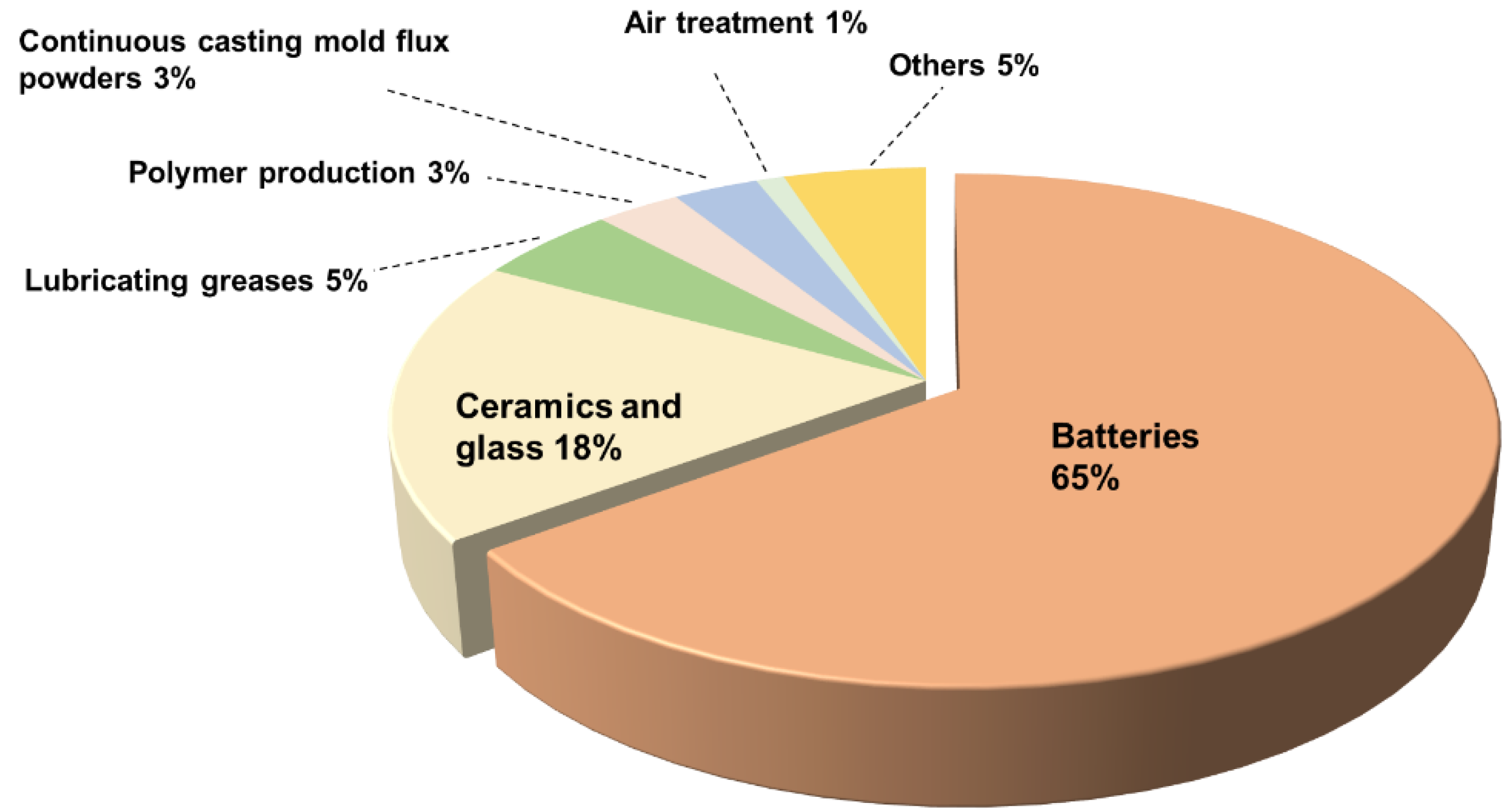
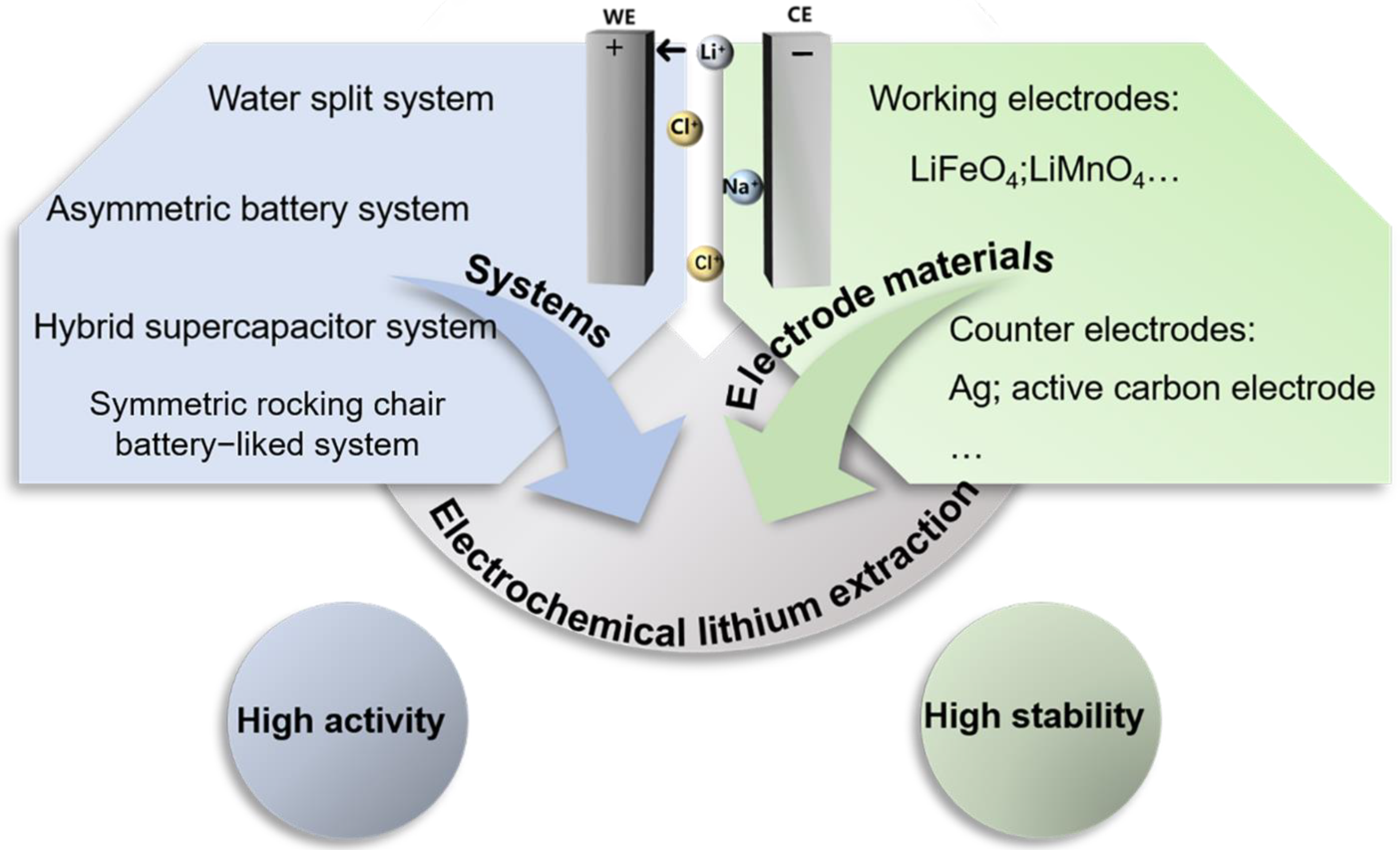


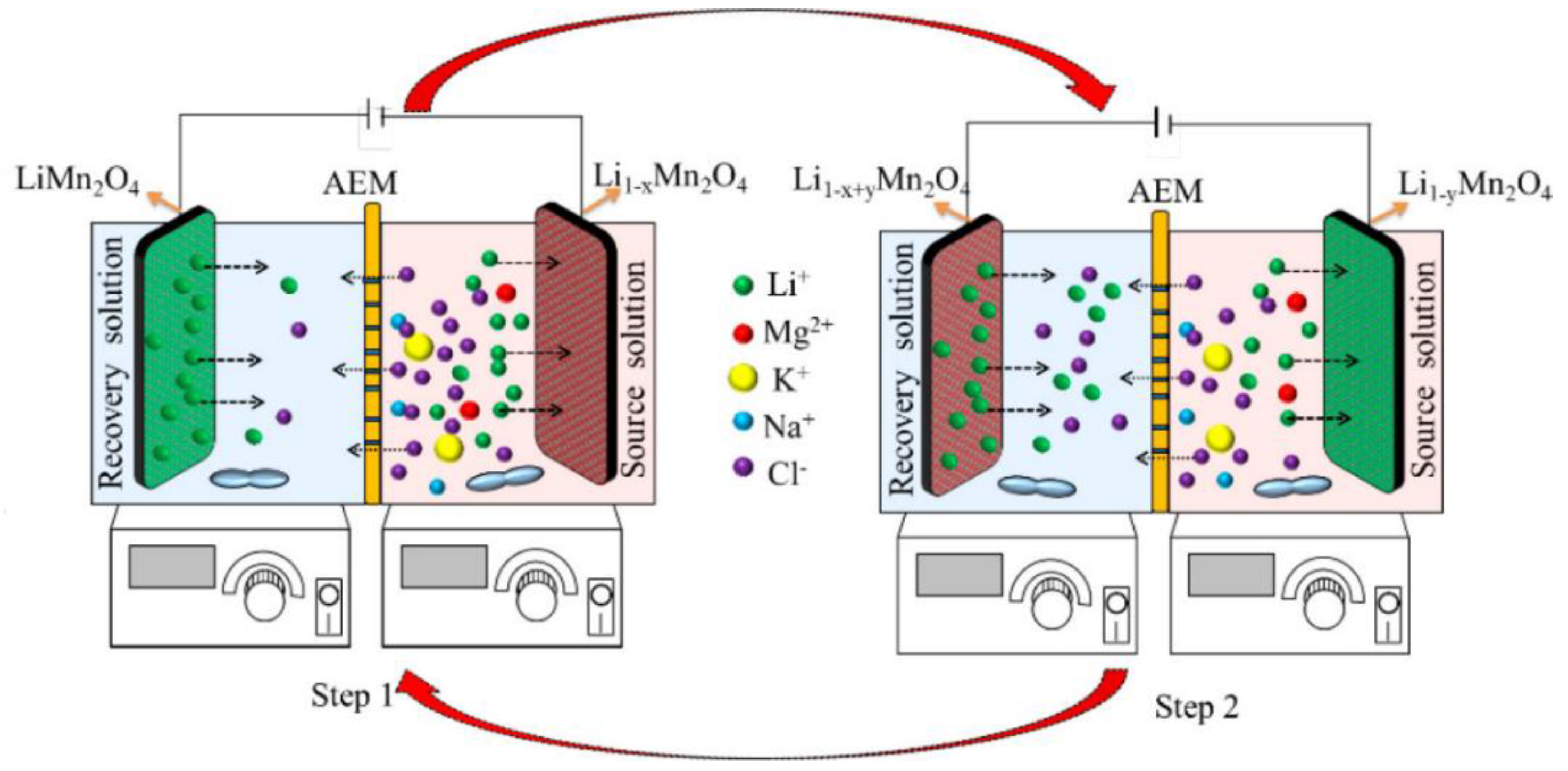




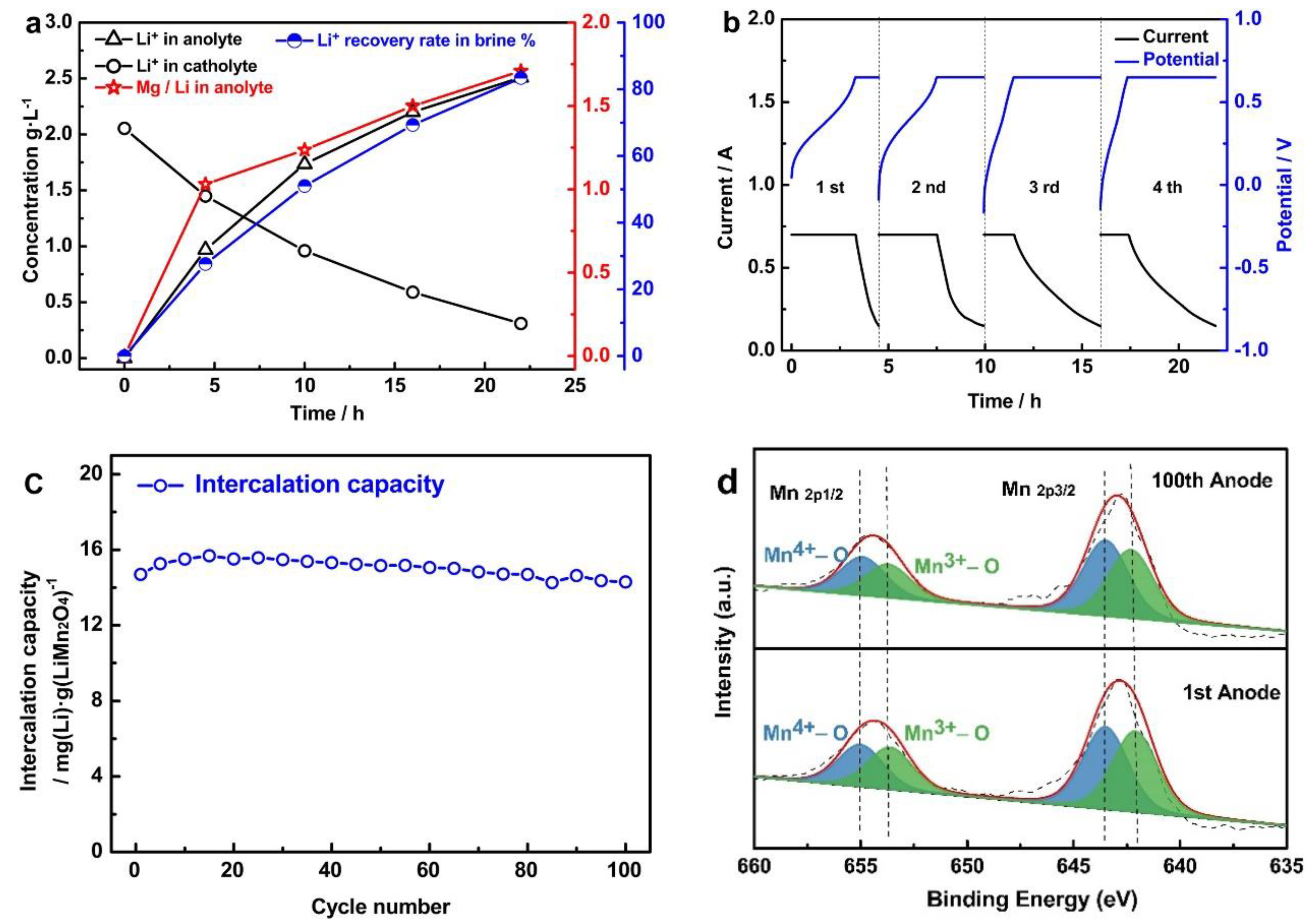
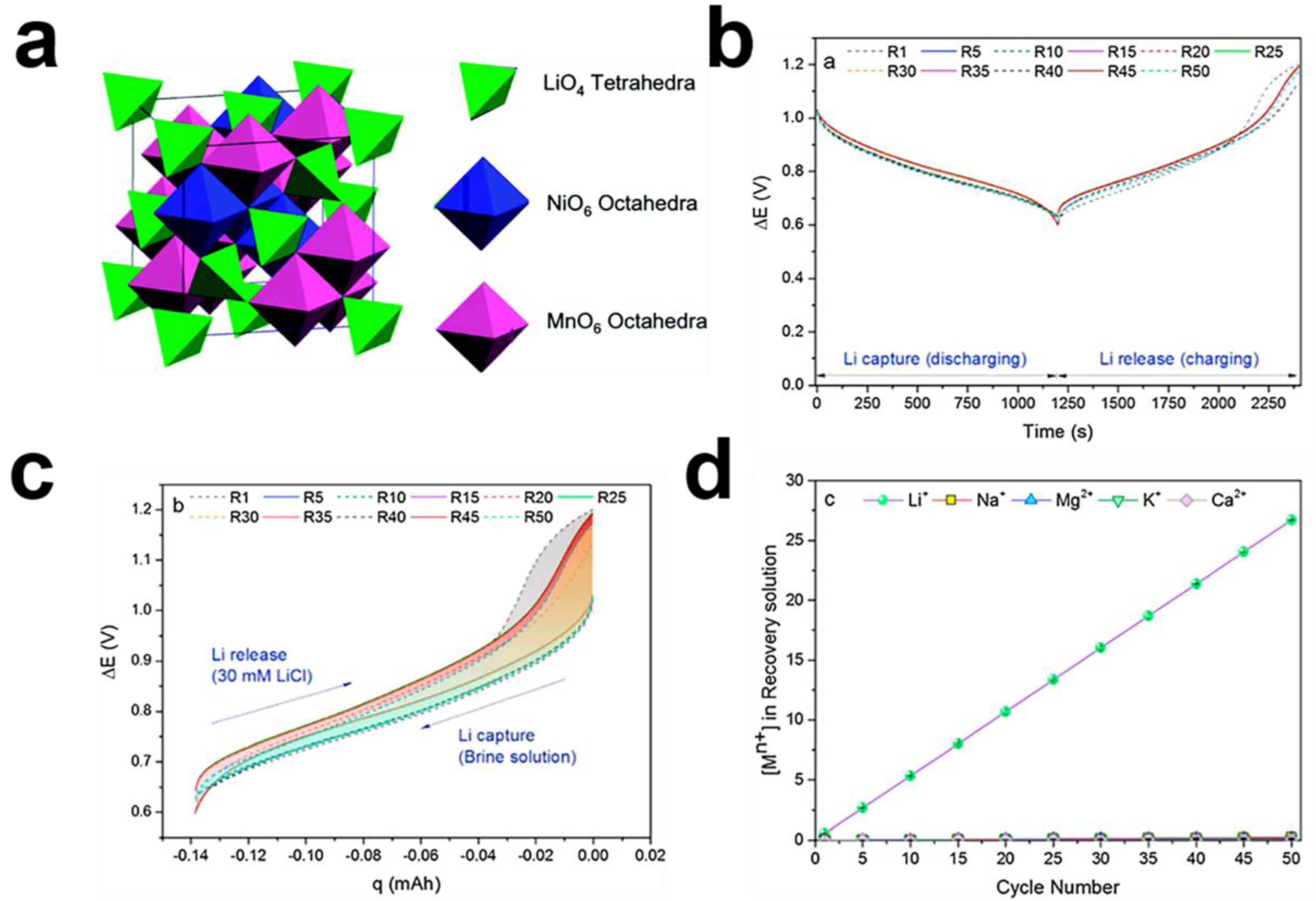

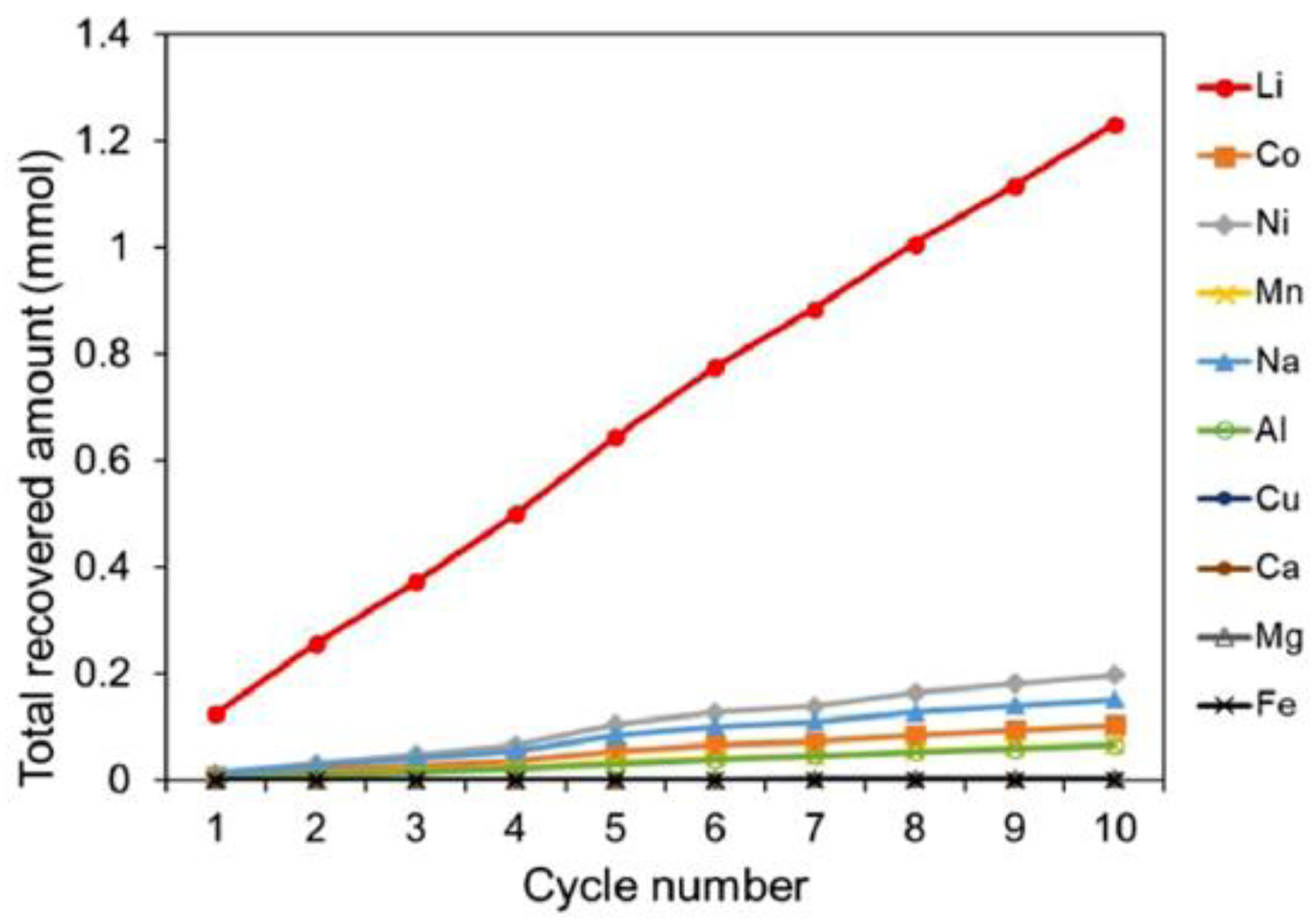
| Source | Electroactive Materials | Energy Consumption (Wh/mol) | Extraction Capacity (mg/g) | Reference |
|---|---|---|---|---|
| Simulated brine | λ-MnO2/Ag | 3.07 | 10.1 | [33] |
| Simulated brine | LMO/L1−xMO | 18 | 22 | [50] |
| Simulated seawater | LMO/L1−xMO | 18.6 | 21 | [50] |
| Salt Lake brine | LiMn2O4/Li1−xMn2O4 | 16 | 15-16 | [65] |
| Simulated brine | LNMO/Ag | 13.32 | 8.74 | [69] |
| Simulated brine | L1−xN1/3C1/3M1/3O2/Ag | 2.6 | 10.83 | [72] |
| Simulated brine | PPy/Al2O3/LiMn2O4 | 1.41 | 12.84 | [73] |
| Simulated brine | λ-MnO2/LiMn2O4-Pt | 23.38 | 75.06 | [74] |
| Simulated brine | LiNi0.038Mo0.012Mn1.95O4 | 7.91 | 14.4 | [75] |
| Simulated Brine | λ-MnO2/BiOCl@PPy | 1.007 | 10.88 | [76] |
Publisher’s Note: MDPI stays neutral with regard to jurisdictional claims in published maps and institutional affiliations. |
© 2022 by the authors. Licensee MDPI, Basel, Switzerland. This article is an open access article distributed under the terms and conditions of the Creative Commons Attribution (CC BY) license (https://creativecommons.org/licenses/by/4.0/).
Share and Cite
Sun, J.; Liang, D.; Meng, X.; Li, Z. Recent Advances in Lithium Extraction Using Electrode Materials of Li-Ion Battery from Brine/Seawater. Processes 2022, 10, 2654. https://doi.org/10.3390/pr10122654
Sun J, Liang D, Meng X, Li Z. Recent Advances in Lithium Extraction Using Electrode Materials of Li-Ion Battery from Brine/Seawater. Processes. 2022; 10(12):2654. https://doi.org/10.3390/pr10122654
Chicago/Turabian StyleSun, Jianpeng, Dongdong Liang, Xiangchao Meng, and Zizhen Li. 2022. "Recent Advances in Lithium Extraction Using Electrode Materials of Li-Ion Battery from Brine/Seawater" Processes 10, no. 12: 2654. https://doi.org/10.3390/pr10122654
APA StyleSun, J., Liang, D., Meng, X., & Li, Z. (2022). Recent Advances in Lithium Extraction Using Electrode Materials of Li-Ion Battery from Brine/Seawater. Processes, 10(12), 2654. https://doi.org/10.3390/pr10122654







